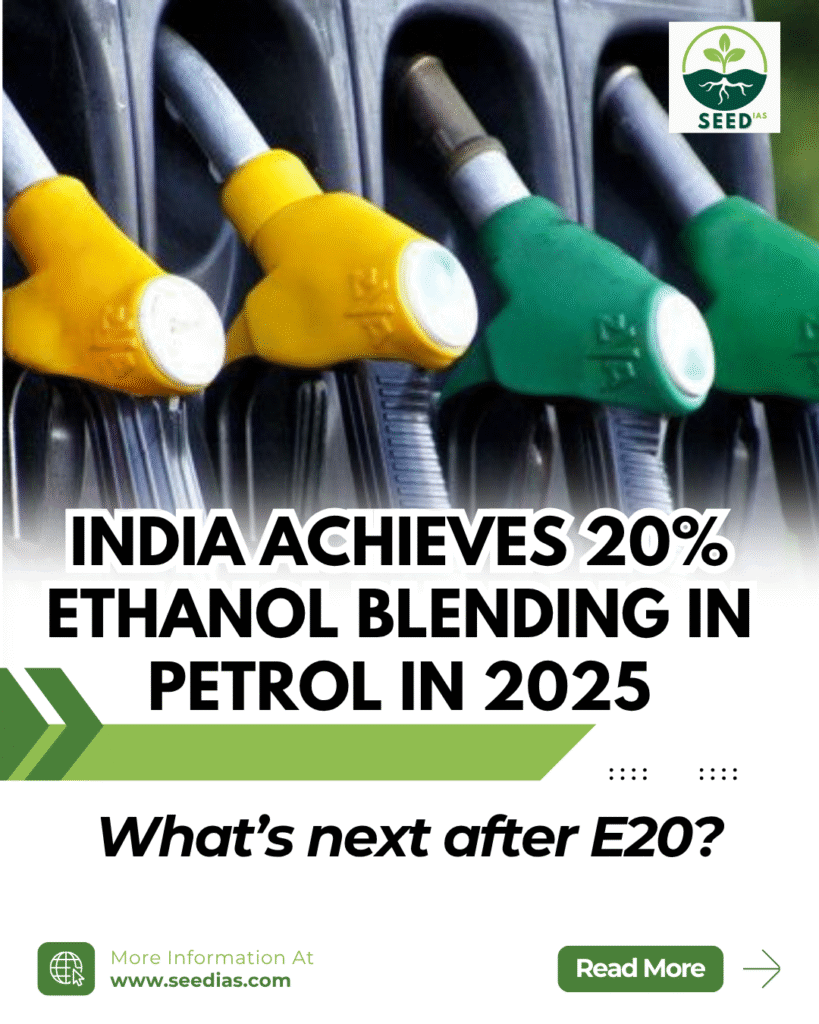Why in NEWS
India has achieved 20% ethanol blending in petrol under the Ethanol Blending Programme (EBP) in 2025—five years ahead of schedule, signaling a major step in its clean energy transition and rural economic empowerment.
Key Terms and Concepts
| Term | Explanation |
|---|---|
| Ethanol Blending | Mixing ethanol (biofuel) with petrol to reduce fossil fuel use and emissions |
| E20 | Fuel blend with 20% ethanol and 80% petrol |
| EBP | Ethanol Blending Programme aimed at increasing ethanol use in transportation fuel |
| National Policy on Biofuels | 2018 policy (amended 2022) promoting biofuels like ethanol from multiple feedstocks |
| FFV | Flex-Fuel Vehicle, runs on higher ethanol blends like E85–E100 |
Factors Behind India’s Ethanol Blending Success
| Area | Key Drivers |
|---|---|
| Policy Push | Advanced E20 deadline from 2030 to 2025-26; allowed flexible feedstock use |
| Institutional Mechanism | NBCC monitors surplus and feedstock usage |
| Advanced Biofuels | PM JI-VAN Yojana incentivizes 2G/3G biofuels from waste |
| Financial Support | Ethanol Interest Subvention Schemes (2018–22) aided plant setup |
| Market Assurance | Long-Term Offtake Agreements ensured demand and payment |
| Pricing Reforms | Assured pricing + GST cut (18% to 5%) + deregulated interstate movement |
Socio-Economic and Environmental Impacts
| Impact Area | Outcomes |
|---|---|
| Farmer Income | ₹1.18 lakh crore earned by farmers till 2025 |
| Rural Jobs | Agro-based industries in states like UP, Bihar, Maharashtra |
| Forex Savings | ₹1.36 lakh crore saved by reducing crude oil imports |
| Crop Diversification | Use of surplus rice, maize, sweet sorghum |
| Make in India | Boosted biofuel economy and energy independence |
| GHG Emission Cut | Avoided 700 lakh tonnes CO₂ |
| Urban Pollution | Lower PM, CO, HC emissions from E10–E20 fuels |
| Waste Utilization | Conversion of damaged food grains and crop residue to ethanol |
Challenges in Deeper Ethanol Integration
| Challenge | Details |
|---|---|
| Food vs Fuel | Use of maize, sugarcane affects food security; India became net maize importer |
| Water Use | Grain-based ethanol needs 8–12 L of water/L ethanol; distillery waste (vinasse) pollutes |
| Climate Risks | Crop failure due to unseasonal rain/drought threatens ethanol supply |
| Pollution | High emissions from distilleries (acetaldehyde, formaldehyde); inadequate EIA in AP |
| Logistics Gaps | Lack of ethanol pipelines, uneven blending across states, poor safety in rural areas |
| Vehicle Compatibility | Most cars are E10-tuned; E20 causes efficiency drop unless engine is retuned |
| 3G Tech Lag | Algae-based ethanol (3G) underdeveloped; needs scale-up and investment |
How Can India Scale Ethanol Blending Beyond E20 Sustainably?
| Strategy Area | Actionable Measures |
|---|---|
| Feedstock Diversification | Promote 3G ethanol (algae), drought-resistant crops like sweet sorghum |
| Technology Push | Mandate FFVs; offer PLI and tax benefits to automakers |
| Infra Upgrade | Develop pipelines, green terminals under NLP 2022 |
| Environmental Safeguards | Mandatory effluent treatment, water recycling, EIA revival, and audits |
In a Nutshell
Memory Code: “FIRM E20 VISION”
- Feedstock flexibility
- Infrastructure support
- Rural income boost
- Make in India push
- E20 target achieved early
- Vehicle technology adaptation
- Industrial safety concern
- Second/third gen tech needed
- Inclusive policy needed
- Oil import cut
- Nature-friendly transition
Prelims Questions
- Which of the following crops is least likely to be promoted under sustainable ethanol blending policies in India?
A) Sweet Sorghum
B) Maize
C) Algae
D) Wheat - Consider the following statements about ethanol blending in India:
- India met its 20% ethanol blending target before 2030.
- The EBP allows ethanol production from only sugarcane-based feedstocks.
- The Pradhan Mantri JI-VAN Yojana supports 3G ethanol production.
Which of the above is/are correct?
A) 1 and 2 only
B) 1 and 3 only
C) 2 and 3 only
D) 1, 2 and 3
- Which of the following is NOT a benefit of ethanol blending in India?
A) Reduction in CO₂ emissions
B) Increase in oil imports
C) Rural employment boost
D) Crop price stabilization
Mains Questions
- How has the Ethanol Blending Programme contributed to India’s goals of energy security, rural development, and environmental sustainability? 10 Marks (GS3 – Economy/Environment)
- Critically analyse the environmental and logistical challenges associated with scaling ethanol blending beyond E20 in India. 15 Marks (GS3 – Infrastructure/Environment)
Answers and Explanations (Prelims)
| Ques | Answer | Explanation |
|---|---|---|
| 1 | D | Wheat is a food staple; its diversion to ethanol raises food security issues |
| 2 | B | Statement 2 is wrong – EBP allows use of non-sugar feedstocks too |
| 3 | B | Ethanol blending reduces, not increases, oil imports |
















